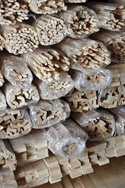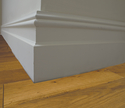Simplicity for straitened times
27 November 2010Mouldings manufacturers have continued to focus on product and design development through the downturn and some now report market improvement
Summary
¦ Producers say the mouldings market has stabilised or shown improvement in 2010.
¦ Cheshire Mouldings saw 30% growth.
¦ Simpler, pared down profiles are more popular.
¦ Manufacturers are responding to the emergence of online moulding businesses.
¦ Demand has held up for bespoke products and some manufacturers are offering non-wood mouldings.
¦ Manufacturers are developing their merchants’ marketing support.
In 2009 the mouldings market was sunk deep in the construction slump mire. This year has been challenging too, but most manufacturers report at least tentative signs of recovery, with some experiencing quite a strong bounce back.
Sales director Gerard Wilson said SAM Mouldings had seen little improvement in volumes to standard housebuilders.
“And the consensus [among merchants] is that, at best, the market is growing at up to 5%,” he said. “But we have seen improvement in RMI, which continues to be relatively strong as people upgrade existing properties.”
David McDonnell of Primer Mould maker W Howard said sales were further depressed by the hard winter, but had picked up since and, in contrast to other producers, it wasn’t just RMI driving business.
“Towards the end of quarter two the industry recovered volume predominantly due to the increase in new build,” he said. “Quarter three has seen a downturn, but not dramatic.”
Opportunities and challenges
Richard Burbidge also acknowledged that trading has been difficult, but said it had identified “opportunities as well as challenges” in the recession.
“We’ve worked to our strengths, communicating with customers to make their moulding ranges work for them, improving delivery and recognising the need for pre-finished products for the growing DIY market,” said mouldings product manager Ian Barnes. As a result, Burbidge had “experienced significant growth” through both DIY and merchant channels.
Most bullish of all was Cheshire Mouldings, which was “delighted” at a 30% jump in sales.
“RMI is definitely holding up, with mouldings a great way for end users to improve [the property] they have,” said managing director John Carney. “Commercial sales are fairly static, but we hope that will improve as the building sector recovers.”
As well as sales, it seems that tough economic times, albeit now showing signs of improvement, have influenced moulding design too. Prior to the crunch there was already a move to less fussy profiles, driven by consumers’ desire for less cluttered, cleaner home or office environments. Some may now want to pierce the gloom of austerity with more flamboyant interior design, but the home style media say for most of us it’s reinforced tastes for the plain and simple. That’s certainly borne out by mouldings producers.
“They may come back in the future, but the highly decorative styles that were in fashion have lost their place in the DIY market,” said Mr Carney. “People want minimalist and our best sellers are quadrants and scotia.”
Burbidge says its customers are also opting for pared down, “more cost-effective, contemporary mouldings”.
According to Finnforest head of merchant sales Darren Pack, the simplification of interiors also seems to be leading to consumers favouring mouldings matched to interior doors and flooring. “That’s increasing demand for foil and real wood veneers and fully-finished white painted products,” he said.
MDF gaining ground
In terms of mouldings materials, timber – principally softwood – remains dominant, with market share put at 65%. However, W Howard reports wood-veneered and foiled MDF continuing to gain ground. This is partly because these are half to three-quarters of the cost.
“But it’s also due to positive environmental issues and the fact that they use a fraction of the raw material resource,” said Mr McDonnell.
The continuing drift to MDF is being seen by James Donaldson too.
“One area that’s seen a significant rise in demand for us is white-primed MDF from our Silktrim brand,” said managing director Iain Torrance. “Sales are up around 40%.”
Within its market, all-timber specialist Cheshire Mouldings says that pine remains the top seller. “But we’ve also seen more interest in oak, especially since launching our oak flooring, which, with our stairparts ranges, has made us a one-stop shop for oak products,” said Mr Carney.
But timber and MDF aren’t the only game in town. In fact, several manufacturers said they’re contemplating other materials options.
“We’ve seen a huge increase in sales of glass stairparts, indicating a definite trend, and if customers start showing interest in different mouldings materials, we’ll consider it,” said Mr Carney.
And Burbidge is already dipping its toe into alternatives. “We have plastic and metal mouldings and are now looking where we can strengthen our offering,” said Mr Barnes.
Several manufacturers also report increased demand for bespoke products, among them SAM, Donaldson and Burbidge. The former said it is “strongly promoting flexibility to offer profiles to order” while Donaldson believes the bespoke market will “show growth over the coming years”.
Burbidge stressed that it remains primarily a volume producer and, according to Mr Barnes, it is ‘discreet’ about its specials service, but it is also getting more enquiries.
Online business
Another factor in today’s mouldings market is online operators selling to both trade customers and consumers. Some, like www.diytimberpacks.com, have been launched by established players, in this case Irish manufacturer Agnew. Others, such skirtingboards.com, ukhomeinteriors.co.uk and skirtingboardsdirect.com, are dedicated online businesses.
Some say these have still not made a big impact on existing market channels. SAM, for instance, does not regard them as “real competition yet due to their selling prices”.
But others see their role increasing and are either responding or considering the option.
Cheshire Mouldings, for instance, is already involved. “We now deal with a limited number of online suppliers,” said Mr Carney. “It’s a good route to end users and we’re happy to support it.”
“Ordering online is not something Howard currently offers,” said Mr McDonnell. “But a merchants’ system may be one for the future.”
However, despite the emergence of this relatively new market channel, plus the established strength of DIY and merchant multiples, the leading suppliers still also see a robust future in mouldings for independent merchants.
“We believe face-to-face sales will always be strong,” said Mr Carney. “End users like to visit their merchant to view a range, get advice and be tactile with what they’re buying and make sure it’s right.”
Mr Wilson agreed: “With the RMI market relatively strong and smaller independents providing availability and knowledgeable service, there’s an attraction for DIY enthusiasts to use them.”
W Howard feels that some merchants may not realise their potential in the market, particularly in MDF. “There’s a misunderstanding among smaller merchants that the availability of MDF mouldings is restrictive and that they’re not easy from stacking and handling perspectives,” said Mr McDonnell. “But 15 products will cover 80% of [sales], requiring only 1.5m² of A-frame space and, with shorter lengths now available, they’re easier to embrace.”
Finnforest agreed that the merchant’s fortunes in mouldings are in their own hands.
“Key sales criteria are product availability, depth of range, quality and knowledge,” said Mr Pack. “Merchants responding to expectations on these, alongside effective merchandising and communication, are likely to outperform others.”
And Mr Barnes maintained that “stocking even the most basic of ranges” can boost a merchant’s profitability. “As long as their moulding box stocks the right range – and our sales team help with that – they can offer customers all they need from one place,” he said.
Marketing support
Burbidge, like other suppliers, also says it is backing merchants with marketing support.
“We undertake an array of activity to generate leads and pull-through, including consumer and trade press promotion,” said Mr Barnes. “We’re also rebranding merchandising and POS material.”
In addition to carousels and rack labelling, Finnforest supplies its merchant customers with counter-top digital screens, e-brochures and promotional mailing leaflets and W Howard provides trade day support and help with customer literature.
Besides increasing its supply of POS material and joint branding and labelling on products, SAM’s regional sales team backs merchants with personal account management and Cheshire says it works with them “to achieve the best possible platform for mouldings”. “The only way to grow business is to work hand-in-hand with merchants,” said Mr Carney. “We act on their feedback on an ongoing basis.”
Market outlook
None of the mouldings manufacturers seem overly bullish about a significant pick-up in business in 2011. The majority expect sales to rise, but only in line with analyst Mintel’s 2% growth forecast for the overall UK timber market. However, they also say that mouldings’ appeal across new build, RMI, DIY trade and retail markets will continue to give them unique resilience through tough times, and the capacity to pick up sales rapidly when the market upturn accelerates.
Several are backing this upbeat longer-term outlook with continuing investment in plant, personnel and new capacity. W Howard, for instance, last year acquired laminated products specialist Polyco, resulting in the launch of its Primer Mould +Plus Polyco range. Donaldson this year rebranded its Chorley mouldings operation and spent £1m on new machinery and Burbidge points to its appointment of Mr Barnes as evidence of its market confidence. Meanwhile, following a rolling machinery investment programme over the last two years, Cheshire Mouldings says it plans to spend another £500,000 by 2012.





